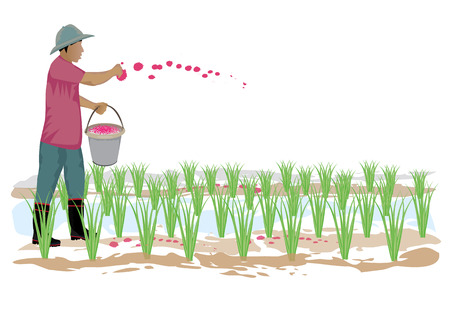Introduction to Village Gardens in India
In the heart of rural India, village gardens stand as vibrant symbols of tradition and self-sufficiency. These green spaces, whether in the form of home courtyards (angan), kitchen gardens (bagicha), or communal plots, have been an integral part of Indian villages for generations. Traditionally, every household maintained a garden not only to grow seasonal vegetables, fruits, and medicinal herbs but also to foster a deep connection with nature and the local ecosystem. Over time, these gardens have evolved—modern methods are now interwoven with age-old practices, reflecting changing lifestyles and the influence of agricultural advancements. Yet, their core purpose remains unchanged: village gardens serve as community hubs where neighbours gather for daily interactions, festivals, and collaborative work. For many families, these gardens are vital sources of fresh produce and herbal remedies, reducing dependency on markets and providing an additional means of livelihood. Thus, village gardens in India are much more than plots of land; they are living traditions that nurture both community spirit and economic resilience.
2. Common Garden Maintenance Practices
Garden maintenance in Indian villages is deeply rooted in traditional wisdom, adapted to the unique climatic and soil conditions found across the country. The following methods are widely practiced and have proven effective for sustaining healthy gardens throughout the seasons.
Mulching: Preserving Moisture and Soil Health
Mulching is a time-honoured technique in Indian villages, often using locally available materials like dried leaves, straw, coconut husk, or sugarcane bagasse. By covering the soil around plants, mulch helps retain moisture—critical during hot Indian summers—and suppresses weed growth. It also gradually decomposes, enriching the soil with organic matter.
Common Mulching Materials Used in Indian Villages
| Material | Availability | Benefits |
|---|---|---|
| Dried Leaves | Very High | Nutrient-rich, improves soil texture |
| Coconut Husk | High (Coastal Areas) | Excellent water retention, biodegradable |
| Sugarcane Bagasse | Moderate (Sugar-producing States) | Adds organic matter, affordable |
Composting: Turning Waste into Wealth
Composting is integral to garden care in India, reflecting the ethos of “waste not, want not.” Vegetable peels, cow dung (gobar), dried grass, and even ash from chulhas (traditional stoves) are composted in pits or heaps. This produces rich, dark compost known as “khaad,” which villagers spread over their gardens to naturally fertilise crops and flowers. Composting not only enhances soil fertility but also reduces dependence on chemical fertilizers.
Key Steps in Traditional Indian Composting
- Select a shaded spot and dig a shallow pit.
- Add alternating layers of green waste (kitchen scraps) and dry waste (leaves, straw).
- Add cow dung or slurry for faster decomposition.
- Keep moist and turn occasionally for aeration.
Water Conservation: Adapting to Monsoons and Droughts
India’s variable climate—from heavy monsoon rains to prolonged dry spells—makes water conservation critical. Villagers employ several indigenous methods:
- Bamboo drip irrigation systems in the North East use gravity to channel water directly to plant roots.
- “Pani Bunds” or earthen embankments around beds trap rainwater and prevent runoff.
- Reuse of household greywater for watering non-edible plants.
Summary Table: Popular Upkeep Techniques & Their Suitability by Region
| Technique | Main Benefit | Best Suited Regions/Climates |
|---|---|---|
| Mulching | Moisture retention & weed control | All regions; vital in arid states like Rajasthan |
| Composting | Nutrient enrichment of soil | Nationwide; especially where farm & kitchen waste is abundant |
| Bamboo Drip Irrigation | Efficient water usage | Northeast India; hilly terrains |

3. Community Participation and Collective Care
In Indian villages, the maintenance of common gardens is a vibrant collective activity that brings together people of all ages, from respected elders to playful children. This communal engagement is deeply rooted in the traditional values of “samudayikta” (community spirit) and mutual support. Typically, garden upkeep tasks are distributed among villagers according to their age, skills, and available time. Elders often provide guidance and share indigenous knowledge about plant care, organic pest management, and seasonal cycles—wisdom passed down through generations. Adults and youth handle physically demanding activities like digging, watering, or composting, while children enthusiastically join in simple tasks such as planting seeds or gathering fallen leaves. This intergenerational collaboration not only ensures the healthy growth of vegetables, flowers, and medicinal plants but also reinforces social cohesion within the community. Regular gatherings for “shramdaan” (voluntary labor) or “gram sabha” (village meetings) further strengthen bonds as villagers collectively decide on garden improvements or address challenges like droughts or pests. These shared responsibilities foster a sense of ownership and pride in the garden’s success, making it more than just a green space—it becomes a living symbol of unity, cultural heritage, and sustainable living for the entire village.
4. Use of Indigenous Tools and Organic Methods
In Indian villages, garden maintenance is deeply intertwined with the use of locally made tools and organic materials, reflecting a sustainable and environmentally conscious approach. These practices not only preserve traditional knowledge but also support rural livelihoods and minimize ecological footprints. The following sections detail common indigenous tools and natural inputs that are widely used in village gardens across India.
Locally Crafted Garden Tools
Village artisans typically produce gardening implements using readily available materials such as bamboo, wood, and iron. These tools are designed for durability, efficiency, and ease of repair—qualities essential for small-scale, labor-intensive farming. The table below outlines some frequently used indigenous tools:
| Tool Name | Material | Main Purpose |
|---|---|---|
| Khurpi | Iron blade with wooden handle | Weeding and soil loosening |
| Hand Hoe (Fawda) | Forged iron head, bamboo handle | Tilling and breaking soil clumps |
| Sickle (Dharati) | Curved iron blade, wooden grip | Harvesting grass, pruning plants |
| Bamboo Basket (Tokri) | Bamboo strips | Carrying compost, weeds, or produce |
Organic Materials for Soil Health and Pest Management
Sustainable gardening in Indian villages relies heavily on organic matter sourced from the immediate environment. Not only do these materials enrich the soil, but they also align with eco-friendly principles by avoiding synthetic chemicals. Below are some commonly used organic methods:
| Material/Technique | Source/Preparation | Application in Gardening |
|---|---|---|
| Panchagavya | Cow dung, cow urine, milk, curd, ghee mixed and fermented | Nutrient-rich bio-fertilizer to boost plant growth and immunity |
| Neem Oil Spray | Oil extracted from neem seeds/leaves | Natural pesticide against common pests and fungal diseases |
| Vermicompost | Decomposed organic waste using earthworms | Improves soil fertility and structure; eco-friendly manure source |
| Ash and Cow Dung Slurry | Ash from firewood/crop residue mixed with cow dung and water | Pest deterrent; enhances soil nutrients like potassium and phosphorus |
| Mulching with Crop Residues or Leaves | Dried leaves, straw, or crop remains spread over soil surface | Conserves moisture, suppresses weeds, adds organic matter as it decomposes |
Cultural Significance of Indigenous Practices
The use of local tools and organic inputs is more than a practical necessity—it is an expression of village identity and respect for nature’s cycles. Many communities pass down these techniques through generations as part of their cultural heritage. By prioritizing indigenous knowledge systems, Indian villages foster resilience and self-sufficiency while contributing to the broader goals of environmental stewardship.
5. Cultural and Religious Significance of Village Gardens
Gardens as Sacred Spaces in Indian Villages
In Indian villages, gardens are not merely patches of greenery but are deeply entwined with cultural and religious traditions. Many households maintain a Tulsi Vrindavan—a sacred basil plant altar—at the center of their courtyards, which is worshipped daily for spiritual protection and good fortune. The presence of specific plants such as neem, mango, banana, and hibiscus in home gardens reflects local beliefs about health, prosperity, and divine blessings.
Role in Festivals and Rituals
Village gardens play an essential role during festivals like Pongal, Makar Sankranti, and Diwali. Freshly plucked flowers and leaves from the garden are used to decorate homes, create rangoli patterns, or offer in temples and at household shrines. During Navratri and other harvest festivals, community members gather in shared green spaces to perform rituals that express gratitude to nature for its bounty.
Everyday Customs and Social Interaction
Apart from religious purposes, gardens facilitate social cohesion within villages. Early mornings often see elders tending to the plants while exchanging stories and wisdom with neighbors. Children learn traditional songs and folk tales under the shade of fruit trees, highlighting how gardens act as informal classrooms for passing on cultural values.
Spiritual Symbolism and Identity
The careful maintenance of village gardens is seen as an offering to deities and ancestors, symbolizing respect for the land and its cycles. These practices reinforce a sense of shared identity and responsibility among villagers. By nurturing their gardens together, communities sustain both their environment and their rich heritage—making these green spaces central to the spiritual and social fabric of rural India.
6. Challenges and Sustainable Innovations
Water Scarcity: A Persistent Hurdle
One of the most pressing challenges faced by Indian villages in maintaining their gardens is water scarcity. Due to irregular rainfall, depleting groundwater levels, and erratic monsoons, gardeners often struggle to provide adequate irrigation for plants. Traditional methods like hand-watering or using buckets from wells are time-consuming and inefficient, especially during the scorching summer months.
Pest Control: Balancing Nature and Yield
Pest infestations also present a major obstacle, as common garden crops such as brinjal, tomato, and okra attract a variety of insects and diseases. While chemical pesticides may offer quick relief, they are not always economically viable or environmentally friendly for rural communities. Moreover, excessive use of chemicals can harm beneficial insects and degrade soil quality over time.
Sustainable Solutions Emerging from Tradition
In response to these challenges, many villages have adopted innovative yet culturally rooted solutions. Rainwater harvesting systems are becoming increasingly popular, allowing communities to collect and store monsoon rainwater for year-round use. Additionally, traditional mulching techniques—using dried leaves or cow dung—help retain soil moisture and suppress weed growth, reducing water usage.
Eco-Friendly Pest Management Practices
Villagers are also turning towards natural pest control methods such as neem oil sprays and intercropping with pest-repellent plants like marigold. These practices not only minimize chemical usage but also preserve local biodiversity and support a healthy ecosystem within the garden.
The Road Ahead: Sustaining Green Spaces
While challenges persist, the resilience and ingenuity of rural Indian communities continue to drive sustainable innovations in garden maintenance. By blending ancestral wisdom with modern eco-friendly practices, villages ensure that their gardens remain lush sanctuaries that nourish both body and soul—upholding a cherished aspect of India’s cultural heritage.


